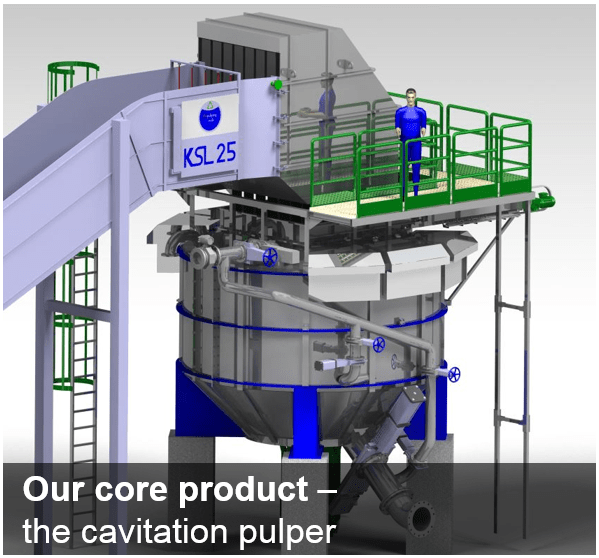The solution
With the cavitation pulper (KSL) Repulping Technology developed an innovative technology by using a physical phenomenon: cavitation.
By using this procedure, it is possible to separate fibres from composite materials in a significantly better and more efficient way in comparison with conventional technology.
State of the art vs. Repulping Technology
Conventional pulpers always use the same principle: after water supply, the separation takes place with friction forces and shear stresses.
The cavitation pulper uses the principle of cavitation – so it is possible to separate fibre/fibre and fibre/non-fibre-material in an optimal way.
The results could clearly be seen!
In various tests with our test equipment we achieved positive results. All following images are taken from tests with the field-test system (V-KSL).
Sample 1: used liquid packaging board
- Input: Used liquid packaging board, not shredded
- Output: Almost 100% fibre free reject, no crushing of the Alu/PE-fraction
Results and advantages:
- Process time saving up to 50% possible (in comparison to state-of-the-art)
- Efficient dissolution enable the use of high qualitiy fibres (comparable to hardwood pulp)
- Alu/PE-fraction remains in large-scale and can be separated very easy in the follow-up treatment
Sample 2: Papercups (both side PE-coated)
- Input: Both side PE-coated papercups, not shredded, stacked into each other
- Output: Almost 100% fibre free reject, no crushing of the PE-foils
Results and advantages:
- Process time saving up to 65% possible (in comparison to state-of-the-art)
- Efficient dissolution enable the use of high qualitiy fibres
- PE-foils remain in large-scale and can be separated very easy in the follow-up treatment
Sample 3: wet-strength labels
- Input: Wet-strength labels in fragmented form
- Output: Dissolved fibre material with small fibre bundles
Results and advantages:
- Process time saving up to 80% possible (in comparison to state-of-the-art) - without chemical treatment
- Efficient dissolution enable the use of high qualitiy fibres
Sample 4: Paper with kraft (brown)
- Input: Paper with kraft, shredded
- Output: Dissolved fibre material with small fibre bundles
Results and advantages:
- Process time saving up to 20% possible (in comparison to state-of-the-art)
- Efficient dissolution enable the use of high qualitiy fibres
Sample 5: Cores
- Input: Not shredded cores
- Output: Dissolved fibre material with small fibre bundles
Results and advantages:
- Time comparison with conventional technology not possible; efficient dissolution of this material only possible with cavitation technology
- Efficient dissolution enable the use of high qualitiy fibres
Special case: Follow-up treatment of fibrous reject
- Input: Fibrous reject material
- Output: Dissolved out fibres (almost 100%)
Results and advantages:
- Time comparison with conventional technology not possible; efficient dissolving out fibres from reject only possible with cavitation technology
- Almost 100% fibre yield by follow-up treatment of reject
- Significant lower transport- and disposal costs
For the follow-up treatment of reject, Repulping Technology developed a separate product line, the reject-catiation pulper (R-KSL). Click HERE for further information.
Would you like to learn more and test your own materials?
We are pleased to test your own, individual raw materials - for the possibilites and more information click HERE. We are looking forward to you!
Precise data and exact time dates for the test results are available on request.
Your team from Repulping Technology GmbH & Co. KG








